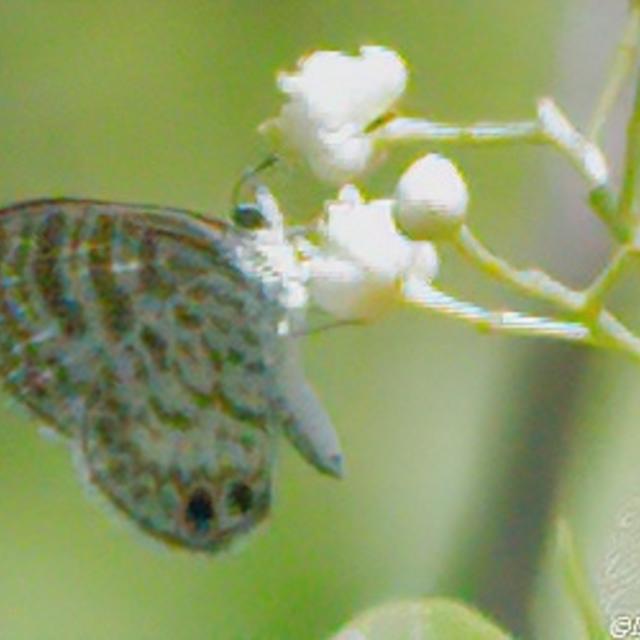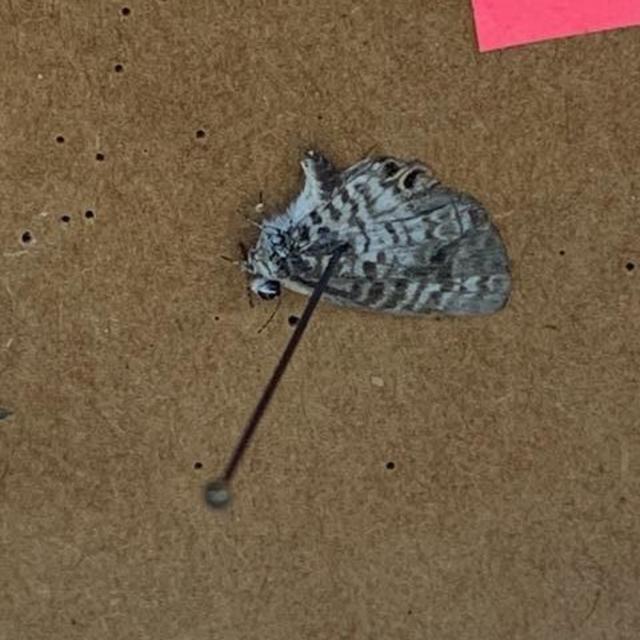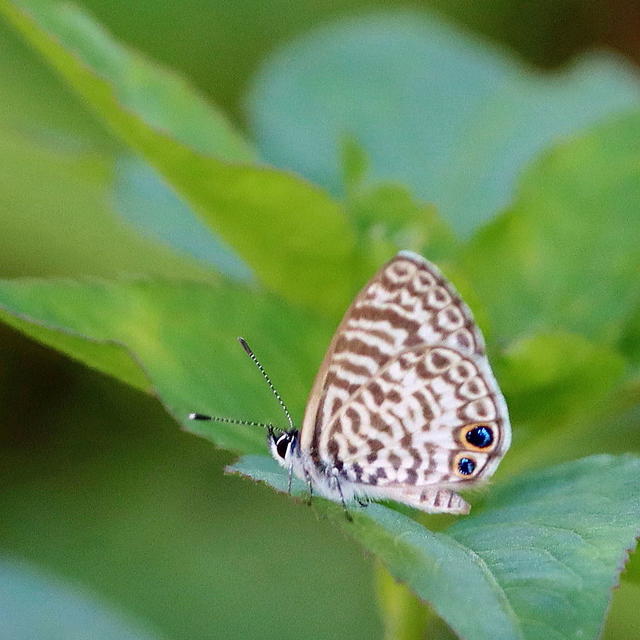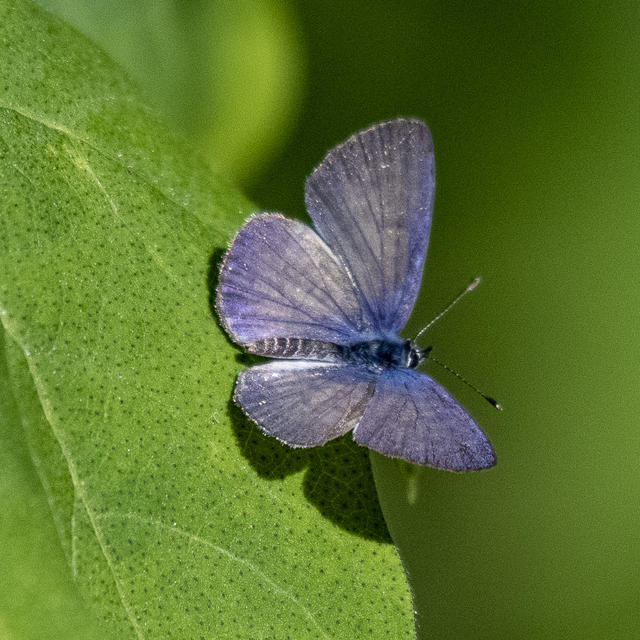Cassius Blue
Leptotes cassius (Cramer, 1775)
Family: Lycaenidae
Subfamily: Polyommatinae
Identification: Upperside of males pale blue; females with white patches. Underside tan with broken pale lines; forewing inner margin has "blank" areas with no spots.
Wing Span: 3/4 - 1 3/8 inches (2 - 3.5 cm).
Life History: Eggs are laid singly on flower buds of the host plant; caterpillars eat flowers and seedpods. Predation and parasitism may be discouraged by ants, which tend the caterpillars and feed on their sugary secretions.
Flight: All through the year in southern Florida and South Texas. Number of broods has not been determined.
Caterpillar Hosts: Ornamental leadwort (Plumbago capensis), rattlebox (Crotalaria incana), hairy milk pea (Galactia volubilis), and lima bean (Phaseolus limensis). Larva has been reared on the crenulate lead plant, Amorpha crenulata.
Adult Food: Nectar from shepherd's needle, lippia, and many other flowers.
Habitat: Subtropical thorn scrub, forest edges, weedy fields, residential areas.
Range: Florida and the Keys; Texas south through the West Indies, Mexico, and Central America to South America. Strays to New Mexico, Kansas, Missouri, and South Carolina.
Conservation: Not usually required.
NCGR: G5 - Demonstrably secure globally, though it may be quite rare in parts of its range, especially at the periphery.
Management Needs: None reported.
Comments: Suzanne Koptur (kopturs@fiu.edu) e-mailed to say that her graduate student Lauren Linares reared a caterpillar on the crenulate lead plant. The adult was determined by Dr. William Kern Jr. of the University of Florida's Institute of Food and Agricultural Sciences in Fort Lauderdale, Florida.
Get your BAMONA Gear!
Please donate!
We depend on donations to keep Butterflies and Moths of North America freely available. We want to express our gratitude to all who showed their support by making a contribution this year. You can donate to support this project at any time.
Advertise with us!
Do you have a product or service that you think would interest BAMONA users? If you would like to advertise on this website, contact us by email, or use the contact form and select the "Advertising" category.
Verified Sightings
Displaying 1 - 24 of 400 verified sightings

Observation date: Apr 17, 2024
Submitted by: Charlie Doggett
Region: Costa Rica
Verified by: Charlie Doggett
Verified date: Apr 27, 2024

Observation date: Dec 27, 2023
Submitted by: LacyJoy
Region: Pasco County, Florida, United States
Verified by: John Calhoun
Verified date: Mar 07, 2024

Observation date: Feb 10, 2024
Submitted by: Charlie Doggett
Region: Costa Rica
Verified by: Charlie Doggett
Verified date: Feb 10, 2024

Observation date: Jun 25, 2023
Submitted by: kericson
Region: Polk County, Florida, United States
Verified by: John Calhoun
Verified date: Nov 11, 2023

Observation date: Jun 26, 2023
Submitted by: ridgeboy
Region: Monroe County, Florida, United States
Verified by: John Calhoun
Verified date: Jul 05, 2023

Observation date: Nov 09, 2022
Submitted by: Robert Gorman
Region: Cameron County, Texas, United States
Verified by: jwileyrains
Verified date: Jun 15, 2023

Observation date: Jun 11, 2023
Submitted by: ReggieGal
Region: Marion County, Florida, United States
Verified by: John Calhoun
Verified date: Jun 13, 2023

Observation date: May 29, 2023
Submitted by: roseg4art
Region: Duval County, Florida, United States
Verified by: John Calhoun
Verified date: May 30, 2023

Observation date: Feb 04, 2023
Submitted by: ezeemonee
Region: El Salvador
Verified by: Paul Prappas
Verified date: May 14, 2023

Observation date: Nov 21, 2022
Submitted by: jrmbutterfly
Region: Nayarit, Mexico
Verified by: Paul Prappas
Verified date: Feb 25, 2023

Observation date: Nov 19, 2022
Submitted by: jrmbutterfly
Region: Nayarit, Mexico
Verified by: jwileyrains
Verified date: Feb 25, 2023

Observation date: May 07, 2021
Submitted by: hasfitz5
Region: Quintana Roo, Mexico
Verified by: Paul Prappas
Verified date: Feb 12, 2023

Observation date: May 05, 2021
Submitted by: hasfitz5
Region: Quintana Roo, Mexico
Verified by: Paul Prappas
Verified date: Feb 12, 2023

Observation date: Nov 22, 2020
Submitted by: ObserverofGod'sart
Region: Bexar County, Texas, United States
Verified by: jwileyrains
Verified date: Feb 05, 2023

Observation date: Jan 06, 2023
Submitted by: Sue Bocchicchio
Region: Monroe County, Florida, United States
Verified by: John Calhoun
Verified date: Jan 08, 2023

Observation date: Jan 06, 2023
Submitted by: Sue Bocchicchio
Region: Monroe County, Florida, United States
Verified by: John Calhoun
Verified date: Jan 08, 2023

Observation date: Jul 24, 2022
Submitted by: dvollmar
Region: Monroe County, Florida, United States
Verified by: John Calhoun
Verified date: Jan 02, 2023

Observation date: Oct 06, 2019
Submitted by: David F Smith
Region: Sonora, Mexico
Verified by: stevecary
Verified date: Dec 12, 2022

Observation date: Dec 02, 2022
Submitted by: John Gibbons
Region: Pinellas County, Florida, United States
Verified by: John Calhoun
Verified date: Dec 05, 2022

Observation date: Dec 02, 2022
Submitted by: emmalarivee
Region: Brevard County, Florida, United States
Verified by: John Calhoun
Verified date: Dec 02, 2022

Observation date: Nov 26, 2022
Submitted by: Sue Bocchicchio
Region: Monroe County, Florida, United States
Verified by: John Calhoun
Verified date: Nov 26, 2022

Observation date: Nov 26, 2022
Submitted by: Sue Bocchicchio
Region: Monroe County, Florida, United States
Verified by: John Calhoun
Verified date: Nov 26, 2022

Observation date: Nov 16, 2022
Submitted by: John Gibbons
Region: Pinellas County, Florida, United States
Verified by: John Calhoun
Verified date: Nov 20, 2022

Observation date: May 14, 2015
Submitted by: XplorMor Intern...
Region: Matanzas, Cuba
Verified by: Paul Prappas
Verified date: Oct 16, 2022
- 1 of 17
- next ›








